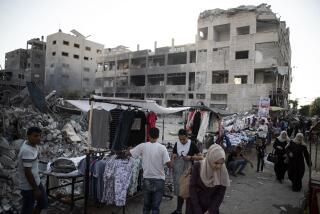EUROPE: FIVE YEARS LATER : THE BERLIN WALL
- Share via
WALL FACTS The Wall began as a barrier between the east and west sides of Berlin, but it was later extended to surround West Berlin, sealing it off entirely from East Germany.
* The concrete structure that faced the West was made up of three-ton panels on average 11 1/2 feet tall, 3 1/2 feet wide and 8 to 10 inches thick.
* In some places, the barrier had up to nine elements, including guard towers and a vehicle barrer trench.
* 45,000 panels were used. Each cost 856 marks to manufacture, or $572 at the current exchange rate.
* The panels were originally intended for use as building blocks for corn silos.
* “Wall-peckers” was the nickname given by Berliners to the entrepreneurs who chiseled out and sold chunks of the Wall as souvenirs.
* East Germany sold 70 of the most interesting panels at auction in Monaco with plans to apply the proceeds to improving health care and restoring historic buildings.
* Average price at auction: 30,000 marks, or about $20,000.
* Many of the 230 panels not sold at the auction have left Berlin as gifts, from the East German government or through private sales.
* Much of the rest of the Wall has either been ground up for paving material or sent back out into the eastern German countryside to be used in construction of corn silos.
WHERE THE WALL IS NOW
Panels from the Berlin Wall are now at sites scattered all over the world, including:
* The Ronald Reagan Presidential Library in Simi Valley, Calif.
* The Freedom Forum World Center in Arlington, Va., a human rights and press freedom center, which has 10 panels and the Checkpoint Charlie guardhouse.
* The John F. Kennedy Library and Museum in Boston.
* CIA headquarters in Langley, Va.
* The collection of Danish artist Jens Galsciot Christophersen, who has two panels in Denmark and others on reserve in Berlin.
* The border between North and South Korea.
* La Gibauderie, the Paris home of cognac heiress and former Yugoslav actress Ljiljana Hennessy.
* The Hotel Metropole Palace in Monte Carlo. This panel was a gift of the East German government.
* The Vatican, the gift of clergymen from the former East Germany.
* The collection of Jaguba Rizzoli in Cap Ferrat.
* Rhein-Main Air Base in Frankfurt, Germany.
* The German town of Dingelstedt, which has made the panel into a sundial.
* The collection of Thomas Steffen, a master baker in the southern German town of Waldshut-Tiengen.
Source: Hagen Koch, Berlin Wall Archive
The Berlin Wall
“Outermost barrier element”: The literal translation of the official East German term for the wall. 101 miles.
Vehicle barrier
Control Strip
Intra-Wall road: For East German army vehicles.
Light row
Guard tower, command post: 190 of them at intervals.
Antitank barrier
Border-indicator fence
Back wall: The faced East Berlin. 42 miles.
One Who Was There
It came suddenly. The Central Committee of the East German Communist Party announced at 7 p.m. that it had decided to relax travel restrictions. Then the state radio indicated that checkpoints along the infamous Berlin Wall would be opened. The flood began. Thousands of East Germans headed, without exit visas, for West Berlin.
It was one of those scenes fixed forever in the memories of correspondents like myself and all the others who were there in Berlin on that flood-lit night of Thursday, Nov. 9, 1989. It was the most dramatic event in Europe since the end of World War II.
East German border guards, instead of shooting, stood by as Berliners passed through the hated and impregnable Wall that had divided their city. Hundreds of jubilant Germans from the East climbed atop the graffiti-scrawled section in front of the massive columns of the Brandenburg Gate to hail the unity of Berlin and all it portended.
In the long, exuberant pre-dawn hours, everyone around me was full of excitement and filled with relief that it had happened without violence. Berlin that night became a capital of hope.
More to Read
Sign up for Essential California
The most important California stories and recommendations in your inbox every morning.
You may occasionally receive promotional content from the Los Angeles Times.













